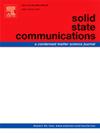Investigation of magnetic properties of disordered Co1.75Ni0.25MnSi full-Heusler alloy
IF 2.1
4区 物理与天体物理
Q3 PHYSICS, CONDENSED MATTER
引用次数: 0
Abstract
We have synthesized Ni-substituted Co2MnSi-based full-Heusler material via the solid-state reaction method. X-ray diffraction (XRD) pattern of synthesized material reveals the presence of disordered full-Heusler structure. Scanning electron microscopy (SEM) measurement displays the morphology of the Co1.75Ni0.25MnSi sample, and the EDS (Energy dispersive X-ray spectroscopy) spectrum of the material confirms the close matching of experimental elemental composition with the nominal composition. Further, magnetization vs magnetic field measurements at 15 K and 300 K temperature display the ferromagnetic ordering of the Co1.75Ni0.25MnSi sample. Small bifurcation between the zero field-cooled (ZFC) and field-cooled warming (FCW) curve indicates the presence of magnetically homogeneous phase for the Co1.75Ni0.25MnSi composition. Structural simulation has performed using Vesta revealed A2 type disordering due to the missing of super reflection peaks.
无序Co1.75Ni0.25MnSi全heusler合金磁性能研究
采用固相反应方法合成了镍取代co2mnsi基全heusler材料。合成材料的x射线衍射(XRD)图谱显示出无序的full-Heusler结构。扫描电镜(SEM)测量显示了Co1.75Ni0.25MnSi样品的形貌,材料的EDS(能量色散x射线能谱)谱证实了实验元素组成与标称成分的密切匹配。此外,在15 K和300 K温度下的磁化与磁场测量显示了Co1.75Ni0.25MnSi样品的铁磁有序。零场冷(ZFC)和场冷升温(FCW)曲线之间的小分叉表明Co1.75Ni0.25MnSi成分存在磁均匀相。利用Vesta进行的结构模拟显示,由于缺少超反射峰而导致A2型紊乱。
本文章由计算机程序翻译,如有差异,请以英文原文为准。
求助全文
约1分钟内获得全文
求助全文
来源期刊

Solid State Communications
物理-物理:凝聚态物理
CiteScore
3.40
自引率
4.80%
发文量
287
审稿时长
51 days
期刊介绍:
Solid State Communications is an international medium for the publication of short communications and original research articles on significant developments in condensed matter science, giving scientists immediate access to important, recently completed work. The journal publishes original experimental and theoretical research on the physical and chemical properties of solids and other condensed systems and also on their preparation. The submission of manuscripts reporting research on the basic physics of materials science and devices, as well as of state-of-the-art microstructures and nanostructures, is encouraged.
A coherent quantitative treatment emphasizing new physics is expected rather than a simple accumulation of experimental data. Consistent with these aims, the short communications should be kept concise and short, usually not longer than six printed pages. The number of figures and tables should also be kept to a minimum. Solid State Communications now also welcomes original research articles without length restrictions.
The Fast-Track section of Solid State Communications is the venue for very rapid publication of short communications on significant developments in condensed matter science. The goal is to offer the broad condensed matter community quick and immediate access to publish recently completed papers in research areas that are rapidly evolving and in which there are developments with great potential impact.
 求助内容:
求助内容: 应助结果提醒方式:
应助结果提醒方式:


